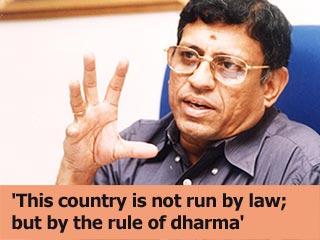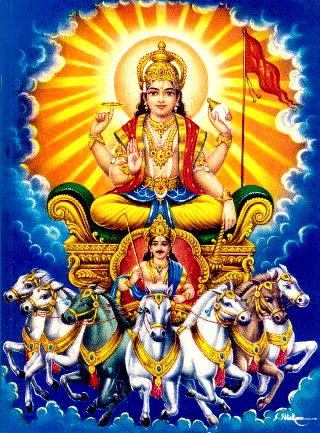Concern for India and Muslims,not hate
S Gurumurthy

"GURUMURTHY need not have waited
for these monsters to surface.
He could have as easily plucked the same verses
and some more from the innumerable
'Hate Islam' websites years ago.
But
why burden a man already consumed by hate."
These unfortunate remarks of Javed Anand,
in his response to my article on
'The Holy Text and Terror' shows how anger has got better of the reason in him.
What he sees hate in me is what,
as I explain here,
I see as the concern in me for both Muslims and India.
I had critiqued the Islamic scholars'
inability to take the jihadis head on and
the seculars engagement with trivia
like Shabhana Azmi's concern for
a better flat in a better locality.
Now read on.Javed Anand reduces my article to two propositions.
First,
"Injustice minus theology
cannot breed deadly terror" and second,
"Muslims are terrorists because
theology (Quran) commands them to kill." He is right on the first and wrong,
even malicious, on the second.
He has not rebutted what I had said,
which is okay;
but he has accused me by saying,
'Muslims are terrorists', which I cannot ignore.
I quote here the central concern of my article.
"So the IM (terrorists) claim is simply this: we are doing what the Quran commands us to do against the non-believers, namely those who do not believe in Islam. The jihadis have openly challenged the pure Islamic theologians to deny that the position it takes against the Hindus is not the position of pure Islam. No Islamic theological school, not a single mullah or maulvi has shown the guts to tell the jihadis that non-believers in Quran do not mean non-Muslims. The Islamist scholars have kept deafening silence. The jihadis have thus effectively shut the Islamists' mouth by quotes from the holy Quran." The core of my concern
— yes, it is concern,
not hate as Javed Anand says in anger — is what is stated in bold letters.
And this is precisely
what Javed Anand side steps.
Every time, anywhere, they strike,
the terrorists — whichever Islamic group they belong to — invariably claim that they are targeting the
'non-believers'. And every time they claim so,
the Islamic theologians issue a standard statement that
'Islam does not countenance
terror against innocent people' and it is a
'religion of peace'. It is true that the Jamiat-ul Ulama-i-Hind
and other organisations held the
'Anti-terrorism Global Peace Conference' at Deoband.
It is commendable that a large gathering of Muslims
at the Ramlila Maidan in Delhi took an oath against terror.
The move is late just by a couple of decades,
as it took place as late as February 25, 2008.
Terrorism has been striking at India,
in Jammu and Kashmir in the 1980s
and elsewhere later from 1990s.
Nevertheless it is a great move
in the national,
and Muslim, interest. But
the move is in no small measure
due to the increasing crescendo of the globally
led debate about whether Islam supports acts
of the terrorists as they claim.
This debate has been started in India and sustained
by many who had to face hostile criticism and calumny
for expressing their concern at the claim of the terrorists that
Islam commanded them to act.
If it were not external pressure
why did the prestigious
Deoband seminary wait for decades
to make its first move to say that terrorism
is not authorised by Islam? Any way better late than never.
Now let us examine the fatwa against terror
issued from Dar-ul-uloom Deoband
which Javed Anand sees as
the Islamic theological counter to the terrorists'
claim of theological support.
The conference defined terrorism as: "Any action that targets innocents,
whether by an individual or by any government
and its agencies or by a private organisation
constitutes an act of terrorism." It also said, "Terrorism negates completely the teachings of Islam
as it is the faith of love and peace and any terrorist
activity which targets innocent people directly
contradicts Islam's concept of peace." And finally, it said, "We reject all forms of terrorism and
do not allow any discrimination.
Terrorism is a completely wrong and
unthoughtful act whoever commits,
irrespective of his association to whatever religion,
community and class he belongs to." Can one fail to notice the qualification of
"innocent people" attached to the fatwa in the already abstract move.
So "Targeting to kill the innocent people" is alone terror according to the fatwa.
If the terrorists target those who are not innocent
— normally the police, army personnel or others,
while they are sleeping or eating, fall in this category —
is that not terror? Let not this side issue,
though significant, detain us.
Now, on to the core issue.
The core element of the terrorists'
claim is, as I have said in my article and emphasised
it here earlier, this: they are commanded
by the holy text to kill the 'non-believers'.
The question is who are non-believers? It needs no seer to say that, for the terrorists,
non-believers are those who do not believe in Islam.
This is what attracts even highly educated
techies and motivates them to turn terrorists
in the cause of Islam against nonbelievers — read non-Muslims.
This is the theological magnet for mobilisation.
This is what Deoband has not rebutted.
It has not said, nor has any other Islamic School,
that 'don't read non-believers in the Quran as non-Muslims'.
If the Islamic clergy declares that
"non-believers does not mean non-Muslims" and issues a fatwa against those
who consider non-Muslims as non-believers,
then, and only then,
the terrorists cannot use theology
as a magnet to attract the Muslim youth kill the non-believers!
That the terrorists make use of Islamic theology
for their actions cannot be denied, and has not been.
Why then do the Islamic scholars not openly
declare that 'non-believers do not mean non-Muslims'? But
they seem to find it difficult.
Here is my personal experience of their difficulty.
In the late 1990s,
a wellmeaning social worker from Calcutta
and lawyer friend of mine (a Muslim) had
organised a Hindu-Muslim dialogue in Madras,
as Chennai was then, to discuss and sort out differences.
In my brief intervention I asked the Islamic scholars present
whether according to Islamic texts
'Hindus' were non-believers (Kafirs)
and said that
if the Hindus were not,
then the problem between
Hindus and
Muslims would be just political, not theological.
After some silence a very prominent Muslim leader
declared that
Hindus were,
as per Islam,
non-believers.
While a majority howled him down,
a theologian came to his rescue,
though in a convoluted manner.
This is the theological gap in the Islamic discourse.
The terrorists are exploiting it.
A clear statement from Islamic schools
that the
'nonbelievers'
does not mean
'non-Muslims'
in Islam
will fill the gap. The Islamic theologians seem to avoid
a confrontation with the terrorists on this point.
This is what my article points out,
and this is what Javed Anand misses or side steps.
It is clear that Javed,
the Muslim, not Javed Anand,
the secularist has dominated the response.
Anyway he should have read my article once more,
before responding.
QED:
When angry, don't write.comment@gurumurthy.ne















